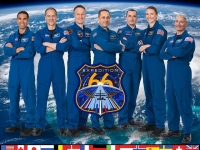News
It’s Business As Usual On The International Space Station
Russian Cosmonauts Still At Work
International Space Station (Source: Astrosurf.com)
USPA NEWS -
Since the Russian/Ukrainian War began, there has not been much said about the International Space Station. There is currently a crew of seven on board – four NASA astronauts, one from the European Space Agency and two Russian cosmonauts.
The current crew aboard the International Space Station are part of the latest mission, called Expedition 66. The mission began in October 2021 and is planned to end this month, March 2022. This expedition will include research investigations focused on biology, Earth science, human research, physical sciences and technology development, providing the foundation for continuing human spaceflight beyond low-Earth orbit to the Moon and Mars. On board from the United States are Mark Vande Hei, Raja Chari, Kayla Barron and Tom Marshburn. From Germany, Matthias Maurer. Lastly, Anton Shkaplerov from Crimea and Pyotr Dubrov from Russia.
Launched in 1998 and involving the U.S., Russia, Canada, Japan, and the participating countries of the European Space Agency—the International Space Station is one of the most ambitious international collaborations ever attempted. The largest space station ever constructed, the ISS continues to be assembled in orbit. It has been visited by astronauts from 18 countries—and counting. The ISS has been the most politically complex space exploration program ever undertaken.
During Expedition 66, crew members will conduct experiments that could help us identify new materials with innate antimicrobial properties that could be used in designing future space craft. New hydrogen sensors will be tested on the station’s oxygen generation system to determine their stability over time. Astronauts will also manufacture optical fibers in microgravity, and contribute to research aimed at improving the infectious disease risk assessment for astronauts (NASA, 2021).
The International Space Station (ISS) Program’s greatest accomplishment is as much a human achievement as it is a technological one—how best to plan, coordinate, and monitor the varied activities of the Program’s many organizations. It brings together international flight crews, multiple launch vehicles, globally distributed launch, operations, training, engineering, and development facilities; communications networks, and the international scientific research community. Elements launched from different countries and continents are not mated together until they reach orbit, and some elements that have been launched later in the assembly sequence were not yet built when the first elements were placed in orbit. Operating the space station is even more complicated than other space flight endeavors because it is an international program.
Each partner has the primary responsibility to manage and run the hardware it provides. Construction, assembly and operation of the International Space Station requires the support of facilities on the Earth managed by all of the international partner agencies and countries involved in the program. These include construction facilities, launch support and processing facilities, mission operations support facilities, research and technology development facilities and communications facilities.
Thank you for reading my article. These are merely my thoughts and insights based on the facts. I use only verified sources. No fake news here. You can check out my website – Small Village Life at smallvillagelife.com, where I share useful articles and news.
Wendy writes for the United States Press Agency and is a former columnist with the Fulton County Expositor, Wauseon, Ohio.
Sources: NASA.com
Wendy writes for the United States Press Agency and is a former columnist with the Fulton County Expositor, Wauseon, Ohio.
Sources: NASA.com
more information: https://smallvillagelife.com
Liability for this article lies with the author, who also holds the copyright. Editorial content from USPA may be quoted on other websites as long as the quote comprises no more than 5% of the entire text, is marked as such and the source is named (via hyperlink).






